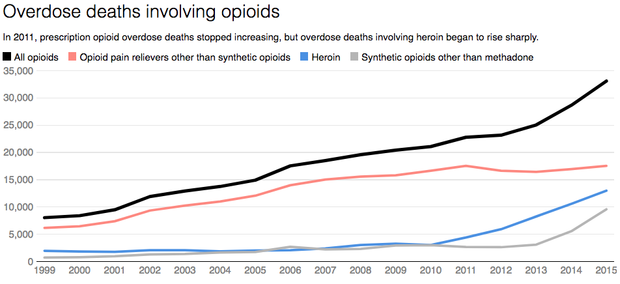 Elaine Zhang, BS
Elaine Zhang, BS
Research Associate
The rise in pain killer prescriptions from doctors combined
with aggressive marketing campaigns from large pharmaceutical companies in the
1990’s awakened a tsunami of addiction that has swept through the US resulting
in significant increase in opioid drug overdose death rates. From 2000 to 2015
more than half a million people died from a drug overdose.1 Since 2011, the rate of drug overdose deaths
due to opioid prescriptions started to level out while death rate due to heroin
overdose experienced a sharp increase, see graph below. In 2016, roughly 64,000
people died due to drug overdoses making it the leading cause of death for
Americans under 50 years old.2

Massachusetts is experiencing the opioid epidemic at a
much higher rate than the rest of US. In 2014, Massachusetts’s age adjusted
overdose death rate was 23.3 per 100,000 which is more than doubled the
national rate of 9.6 per 100,0003. In 2017, there were 932 confirmed
opioid related deaths in Massachusetts; 76% of deaths were male and 24% were female.4
The opioid epidemic also affects the white non-Hispanic population at a much
higher rate than any other race. Of the 932 confirmed opioid-related deaths in
2017, 81% or 753 of those deaths were of people of white non-Hispanic race/ethnicity.
This group has historically had higher death rates than any other race/ethnic
group in the past three years4, see graph below.
At a county level, certain counties are experiencing
higher opioid overdose death rates than other ones. Barnstable, Berkshire,
Bristol, Duke, Essex, Norfolk, Plymouth, and Worcester counties currently have
the highest opioid overdose death rate,5 see map below.
In October 2017, the president declared the opioid
epidemic a national public health emergency. The Department of Health and Human
Services has outlined a five-point strategy to combat the opioid epidemic:
1.
Improving access to treatment and recovery
services
2.
Promoting use of overdose reversing drugs
3.
Strengthening our understanding of the epidemic
through better public health surveillance
4.
Providing support for cutting edge research on
pain and addiction
5.
Advancing better practices for pain management.
The Center for Disease Control and Prevention (CDC)
awarded $28.6 million in funds to 44 states and the District of Columbia to
help strengthen prevention efforts and better understand the epidemic through
public health data6, which aligns with part of the HHS five point
strategy.
In 2015, Massachusetts Governor Charlie Baker signed
Chapter 55 into law in response to the opioid epidemic. The new law allowed
different government data sets to be analyzed to help guide policy decisions
and better understand the opioid epidemic.7 The Baker administration
also allocated $34.5 million to combat the opioid epidemic through raising
awareness, increasing prevention, and providing education. Recent data shows
that in the first 9 months of 2017 there were 167 fewer opioid related overdose
deaths when compared to the first 9 months of 2016, a 10% drop in deaths.8
Along with the decrease in deaths, there has also been a 30% decrease in the
number of patients who were prescribed an opioid in the third quarter of 2017
when compared to the first quarter of 2015.8
At ICH, we work on several projects that focus on the
opioid substance use disorders. SUSTAIN Communities Evaluation is an initiative
funded by the GE Foundation with support from Partners HealthCare. SUSTAIN
Communities provide grants and technical assistance to community health centers
to build capacity for Medication Assisted Treatment (MAT) for patients with
opioid use disorder. ICH Assistant
Director of Research, Leah Zallman, MD, MPH, works on a project funded by a
small foundation (McManus) that uses electronic health record data to
understand the relationship between opioid prescriptions and the development of
opioid abuse disorder. ICH is looking into Cambridge Health Alliance data among
patients who have ever been prescribed opioids and tracking how many developed
opioid use disorders, how long it took, and what are the clinical predictors. Promoting
Older Women’s Engagement in Recovery (POWER) is a collaborative project aimed
at the prevention of opioid misuse in older women ages 55 or older in Cambridge
and Somerville. The Institute for Health and Recovery received the grant and works
alongside with Cambridge Health Alliance, Somerville Cambridge Elder Services,
and the Cambridge Council on Aging to address the risk factors of opioid misuse
among older women through technical assistance for partnership sites and direct
support groups for women 55+. ICH is the
evaluator on the project.
If you or someone you know is struggling with addition,
there are some resources available to help. The Massachusetts SubstanceAbuse Information and Education Helpline provides free and confidential
information and referrals for alcohol and other drug abuse problems. The
Institute for Health and Recovery helps families and youth with substance abuse
issues access publicly funded services. The Suboxone Hotline Office Based
Opioid Treatment Program at Boston Medical Center provides referrals and
information on opiate and heroin treatments available at doctor’s offices
statewide. Cambridge Health Alliance
offers an outpatient addiction service which helps adults to and maintain
sobriety. The Fresh Start Alcohol and Drug Recovery Group is an anonymous peer
support group that meets on Thursday evenings at CHA Revere Care Center. Smart
Recovery is a scientifically tested program for adults who want to manage their
addiction and is held every Tuesday evening at CHA Everett Care Center.
Below are the numbers for each helpline:
The Massachusetts
Substance Abuse Information and Education Helpline:
Phone Toll Free: 1-800-327-5050
TTY: 1-888-448-8321
The Institute
for Health and Recovery:
Phone: 1-866-705-2807
TTY: 1-617-661-9051
TTY: 1-617-661-9051
Suboxone
Hotline Office Based Opioid Treatment Program at BMC:
Phone: 1-866-414-6926 or 1-617-414-6926
Sources:



